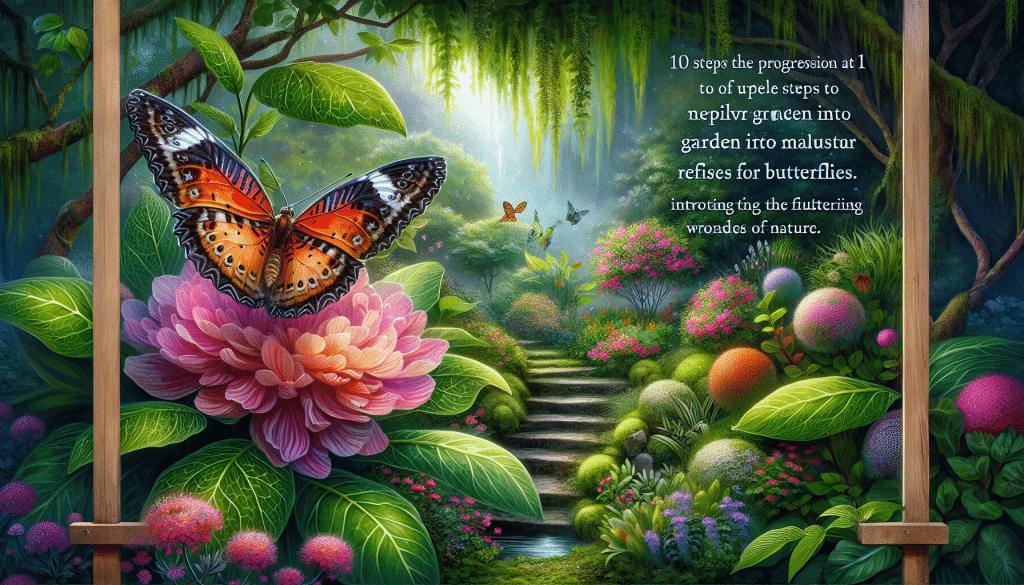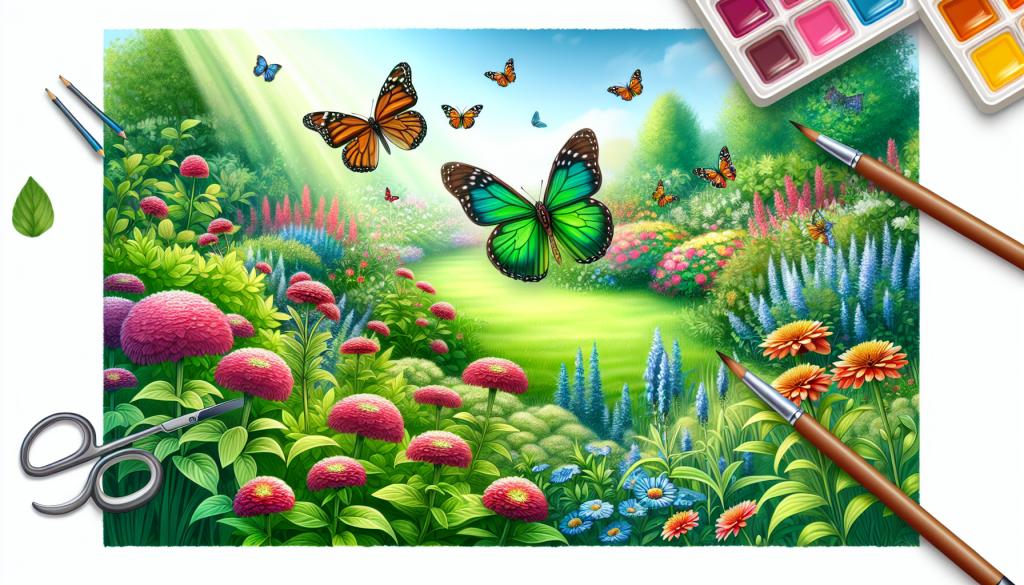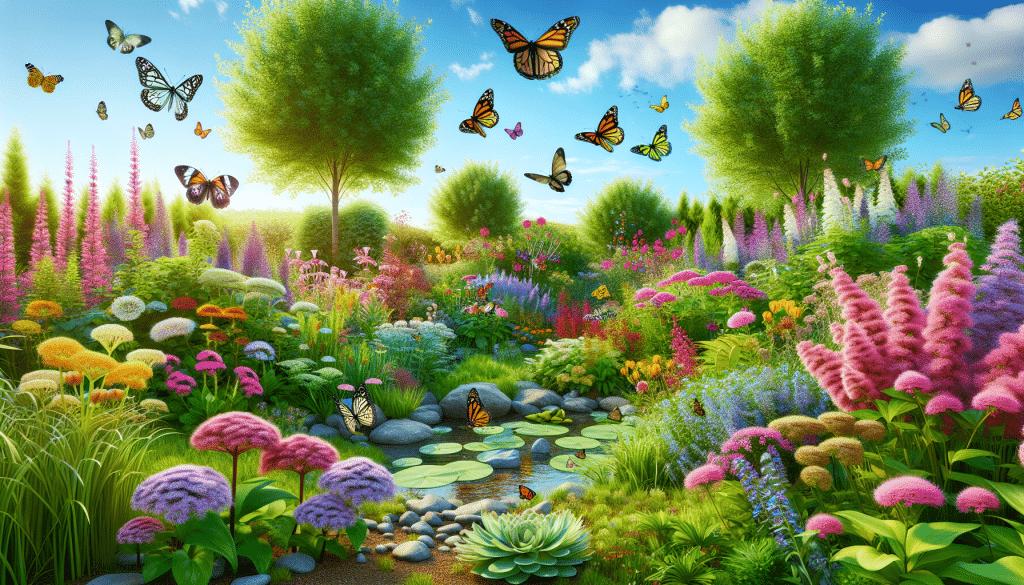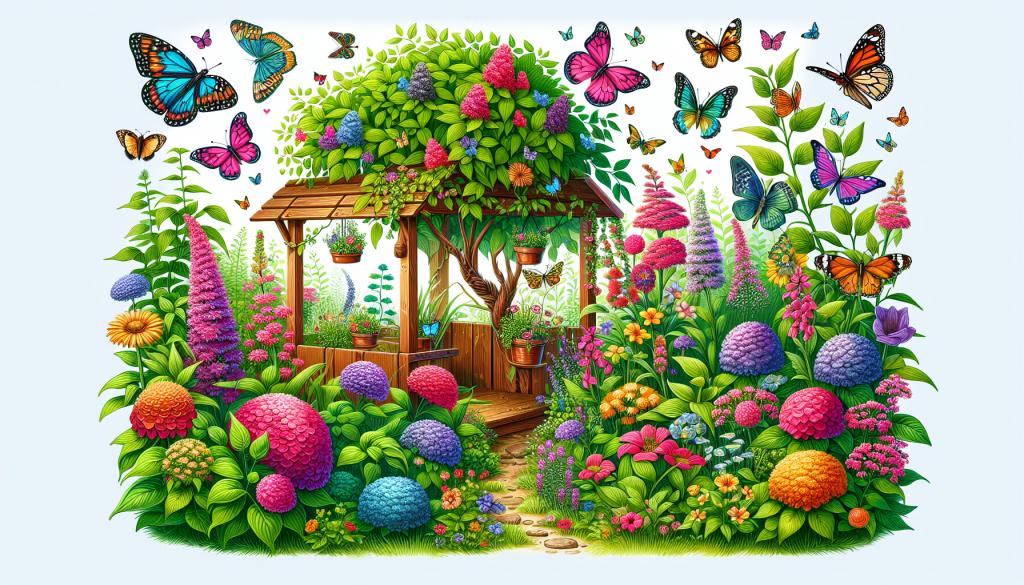Thinking about transforming your yard into a butterfly haven? Look no further, because we’ve got you covered with these 10 simple steps to create a butterfly-friendly haven right in your own backyard. From selecting the right native plants to providing ample water sources, this article will guide you through each step, ensuring that your yard becomes a vibrant and welcoming sanctuary for these beautiful creatures. So, grab your gardening gloves and get ready to embark on an exciting journey of coexistence with nature in your very own butterfly paradise!

Understanding Butterfly Habitats
Basics of Butterfly Biology
To create a butterfly-friendly yard, it is important to first understand the basics of butterfly biology. Butterflies undergo a fascinating life cycle known as complete metamorphosis, consisting of four stages: egg, larva (caterpillar), pupa (chrysalis), and adult butterfly. Each stage requires specific environmental conditions and food sources. By understanding these stages, you can provide the necessary elements for butterflies to complete their life cycle successfully in your yard.
Native Butterflies and Their Preferences
Different butterfly species have specific preferences when it comes to their habitats and food sources. To attract native butterflies, it is crucial to research and understand which species are found in your region. Native butterflies have adapted to the local climate and plant species, making them more likely to thrive in your yard. By choosing plants that cater to their specific needs, you can create an environment that attracts and supports a diverse range of native butterflies.
The Essentials of Butterfly Conservation
Butterfly populations are declining due to habitat loss, pesticide use, climate change, and other factors. Creating a butterfly-friendly yard is not only a beautiful addition to your home but also a vital step towards conservation. By providing suitable habitats and food sources, you can contribute to the conservation of butterfly species and promote biodiversity in your community. Understanding the essentials of butterfly conservation will guide you in making informed choices when creating your butterfly-friendly garden.
Choosing the Right Location
Analyzing Your Yard’s Microclimate
Before designing your butterfly garden, it is essential to assess your yard’s microclimate. This includes factors such as sunlight exposure, wind patterns, and soil type. Different butterfly species have varying preferences when it comes to these environmental factors, so understanding your yard’s unique conditions will help you create a garden that meets their needs. Some butterflies prefer sun-drenched areas, while others thrive in partially shaded spots. By analyzing your yard’s microclimate, you can tailor your garden design accordingly.
Considering Sunlight and Wind Patterns
Sunlight and wind patterns play a crucial role in butterfly habitat selection. Butterflies require sunlight for warmth and energy, so it is essential to consider the exposure of your garden to sunlight throughout the day. Additionally, strong winds can be detrimental to butterflies, as it can make flying and feeding difficult. By identifying areas with optimal sunlight and wind protection, you can enhance the attractiveness and functionality of your butterfly garden.
Avoiding Pesticide-Contaminated Areas
Pesticides are harmful to butterflies and can have devastating effects on their populations. When choosing the location for your butterfly garden, it is important to avoid areas that may have been exposed to pesticides or chemicals. This includes areas near agricultural fields, roadside ditches, or areas treated with lawn chemicals. Pesticide contamination can persist in the soil and plants, posing a threat to butterflies. Selecting a pesticide-free location will ensure a safe environment for these delicate creatures.

Designing Your Butterfly Garden Layout
Creating a Diverse Plant Structure
To attract a wide variety of butterflies, it is crucial to create a diverse plant structure in your butterfly garden. This involves incorporating plants of varying heights, textures, and colors. Butterflies have different preferences when it comes to perching, feeding, and laying their eggs. By providing a range of plant structures, such as tall trees, shrubs, and groundcovers, you create a more inviting and functional habitat for butterflies.
Incorporating Nectar and Host Plants
Butterflies rely on two types of plants: nectar plants for feeding and host plants for nurturing their caterpillars. Incorporating a mix of nectar plants, which produce vibrant and fragrant flowers, will attract adult butterflies to your garden. Host plants, on the other hand, serve as a food source for caterpillars, and different species of butterflies require specific host plants. By including both nectar and host plants, you create an ecosystem that supports the entire butterfly life cycle, from egg to adult.
Aesthetic Considerations for Year-Round Interest
While creating a butterfly-friendly garden is primarily about providing the right plants and habitats, aesthetic considerations can enhance the overall experience. By choosing plants with different bloom times and foliage colors, you can create a visually appealing garden that offers year-round interest. Additionally, incorporating features such as decorative stones, garden art, or seating areas can make your butterfly garden a place of tranquility and enjoyment for both you and the butterflies.
Selecting Butterfly-Attracting Plants
Researching Native Plants
When selecting plants for your butterfly garden, it is crucial to prioritize native species. Native plants have co-evolved with local butterfly species and provide the most suitable food sources and habitats. Research the native plants that are preferred by butterflies in your region and consider incorporating them into your garden. Native plants are often more resilient, require less maintenance, and support a wide range of other local wildlife, making them an excellent choice for a butterfly-friendly yard.
Considering Bloom Times for Sustained Feeding
To ensure a sustained food supply for butterflies, it is important to choose plants that bloom at different times throughout the year. By selecting plants with staggered bloom times, you provide continuous nectar sources for adult butterflies. This is particularly important during migration periods or when food sources may be scarce. Consider including early bloomers, mid-season bloomers, and late bloomers in your garden to accommodate the feeding needs of butterflies throughout the seasons.
Plant Varieties for Different Butterfly Species
Different butterfly species have specific preferences when it comes to nectar plants, so it is important to choose a variety of plant species that cater to their needs. Research the butterfly species that are commonly found in your area and select plants that are known attractants for those species. By offering a diverse selection of nectar plants, you increase the chances of attracting a wide range of butterflies to your garden.

Planting Host Plants for Caterpillars
Understanding the Role of Host Plants
Host plants are essential for the survival and reproduction of butterflies. These plants serve as food sources for caterpillars and provide the necessary nutrients for their development. During the caterpillar stage, butterflies have specific host plant preferences, and different species of butterflies require different host plants. By planting a variety of host plants, you create a favorable environment for caterpillars to thrive and complete their life cycle.
Selecting Specific Host Plants for Native Caterpillars
To attract and support native butterflies in your yard, it is important to research and select host plants that are preferred by the caterpillars of those species. Native caterpillars have co-evolved with specific host plants, so providing these plants is crucial for their survival and the overall health of butterfly populations. By selecting native host plants, you create a habitat that supports the complete life cycle of butterflies, from egg to caterpillar to adult.
Plant Grouping Strategies for Caterpillar Feeding
To make it easier for caterpillars to find and feed on their host plants, consider grouping these plants together in your garden. Clustering host plants provides a concentrated food source, making it more accessible for caterpillars to locate and consume. Additionally, planting host plants in close proximity to nectar plants creates a favorable environment for butterflies, allowing them to easily transition between feeding and laying eggs.
Providing Nectar Sources for Adult Butterflies
Identifying High Nectar Yielding Flowers
To attract adult butterflies, it is important to identify and include high nectar-yielding flowers in your garden. These flowers produce an abundant supply of nectar, serving as a valuable food source for butterflies. Look for flowers with brightly colored petals, as butterflies are attracted to vibrant colors. Some examples of nectar-rich flowers include coneflowers, milkweed, black-eyed Susans, and butterfly bushes. By incorporating these flowers into your garden, you create an irresistible feeding ground for adult butterflies.
Timing Blooms for Continuous Nectar Supply
To ensure a continuous supply of nectar throughout the season, it is important to select plants that bloom at different times. By staggering the bloom times of nectar plants, you provide a consistent food source for adult butterflies. This is particularly crucial during periods when natural nectar sources may be limited. Research the bloom times of different plant species and create a planting schedule that ensures a steady nectar supply from early spring to late fall.
Maintenance Tips for Nectar Plants
To maintain healthy nectar plants in your butterfly garden, proper care and maintenance are necessary. Regularly watering and fertilizing the plants, removing weeds, and deadheading faded flowers will help promote healthy growth and continuous blooming. Additionally, ensuring sufficient airflow and addressing any pest or disease issues promptly will help maintain a thriving nectar source for adult butterflies.

Incorporating Water Features for Hydration
Designing Shallow Water Sources for Butterflies
Butterflies require water not only for hydration but also for other essential activities, such as mating and dissolving minerals. To provide water sources for butterflies, consider incorporating shallow dishes or saucers filled with water in your garden. These water sources should have a few small rocks or pebbles for butterflies to perch on while drinking. Placing water sources at ground level or among low-growing plants makes them easily accessible and reduces the risk of drowning for butterflies.
The Importance of Mud Puddles
In addition to shallow water sources, mud puddles are essential for butterflies. Male butterflies often gather around muddy areas to extract moisture and essential minerals. To create a mud puddle, simply dig a shallow depression in the soil and keep it moist. You may also consider adding organic matter, such as compost or rotting fruit, to attract butterflies to the puddle. Mud puddles provide vital nutrients for butterfly survival, so incorporating them into your garden is crucial.
Safe Water Practices to Prevent Mosquito Breeding
While providing water sources for butterflies is important, it is equally important to prevent mosquito breeding in your garden. Mosquitoes can pose a significant health risk, so it is important to take precautions. Avoid stagnant water sources and regularly change the water to prevent mosquito larvae from developing. Additionally, consider using mosquito dunks or adding mosquito fish to any larger water features to control mosquito populations naturally.
Avoiding the Use of Pesticides
Understanding the Harmful Effects of Pesticides
Pesticides are detrimental to butterflies and other beneficial insects. They can kill butterflies directly or indirectly by contaminating their food sources. Pesticides may also disrupt the delicate balance of ecosystems and negatively impact butterfly populations. To create a butterfly-friendly yard, it is essential to avoid the use of pesticides, including herbicides, insecticides, and fungicides. Instead, opt for natural pest control methods to manage any potential issues in your garden.
Natural Pest Control Alternatives
There are several natural pest control methods you can employ to manage pests in your butterfly-friendly yard. These include handpicking insects, attracting beneficial insects like ladybugs and lacewings, using insecticidal soaps or neem oil, and practicing proper garden hygiene. By encouraging a diverse range of beneficial insects, you can create a natural balance that helps control pests without harming butterflies or the environment.
Monitoring and Managing Plant Health Organically
Regularly monitoring the health of your plants is essential in maintaining a butterfly-friendly garden. By being proactive, you can identify potential pest or disease issues early on and address them using organic methods. This may include removing affected plant parts, increasing airflow, or applying organic pest deterrents. By taking a natural and proactive approach to plant health, you can create a thriving garden that is environmentally friendly and safe for butterflies.

Creating Shelter and Hiding Spots
The Need for Shelter in Butterfly Habitats
Shelter is essential for butterflies to seek refuge from extreme weather conditions and predators. By providing shelter in your butterfly garden, you create a more secure and inviting habitat for butterflies. Natural elements such as tall grasses, shrubs, or trees can serve as hiding spots and roosting sites for butterflies. These sheltered areas also provide protection during mating and egg-laying activities. Consider incorporating a mix of native plants that offer different levels of coverage to meet the varying shelter needs of butterflies.
Utilizing Natural Elements for Cover
When creating shelter in your butterfly garden, it is best to utilize natural elements rather than man-made structures. Native plants with dense foliage, such as ferns or evergreen shrubs, provide excellent cover for butterflies. Additionally, allowing your grass to grow slightly longer in certain areas can create natural hiding spots. By working with nature and incorporating these natural elements, you create a more authentic and effective shelter for butterflies.
Integrating Man-made Structures as Shelter
While natural elements should be the primary focus for shelter, man-made structures can also serve as effective hiding spots for butterflies. For example, strategically placing butterfly houses, trellises, or even large planters with dense vegetation can provide additional options for shelter. These structures should mimic natural elements and be positioned in areas that offer protection from wind and extreme weather. By integrating man-made structures as shelter, you enhance the overall functionality and appeal of your butterfly garden.
Educating Yourself and Community Involvement
Engaging in Local Butterfly Conservation Efforts
To make a more significant impact on butterfly conservation, consider getting involved in local butterfly conservation efforts. Joining butterfly monitoring programs, participating in habitat restoration projects, or volunteering at butterfly gardens or nature centers can provide valuable opportunities to contribute to the conservation of butterflies. By engaging in these initiatives, you can gain knowledge, share experiences, and inspire others to appreciate and protect butterflies in your community.
Staying Informed on Best Practices for Butterfly-Friendly Gardening
Butterfly-friendly gardening practices are continually evolving, and staying informed on the latest research and best practices is crucial. Subscribe to newsletters, follow butterfly conservation organizations, and join online forums or social media groups dedicated to butterfly gardening. By staying up to date, you can continuously improve your butterfly garden and make informed decisions that benefit both butterflies and the environment.
Spreading Awareness and Encouraging Neighbors to Create Butterfly Habitats
One of the most effective ways to support butterfly conservation is by spreading awareness and encouraging others in your community to create butterfly habitats. Share your knowledge and experiences with neighbors, friends, and local gardening clubs. Host workshops or garden tours to showcase the beauty and importance of butterfly-friendly gardening. By empowering others to take action, you can create a network of butterfly-friendly gardens and contribute to the overall conservation efforts on a broader scale.
Creating a butterfly-friendly yard is a rewarding and meaningful endeavor. By understanding the basics of butterfly biology, selecting the right location, designing a suitable layout, and selecting the right plants, you can create a thriving habitat that attracts and supports a diverse range of native butterflies. Remember to avoid the use of pesticides, provide water sources and shelter, and stay informed about butterfly conservation practices. By educating yourself and encouraging community involvement, you can make a positive impact on butterfly populations and contribute to their long-term survival. So roll up your sleeves, grab a shovel, and start creating a butterfly-friendly garden that will delight both you and these beautiful creatures.
